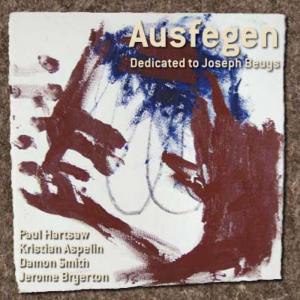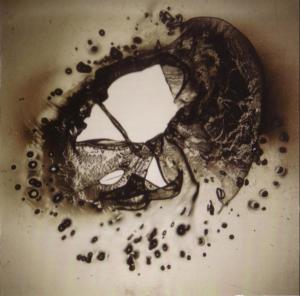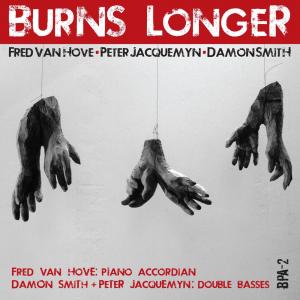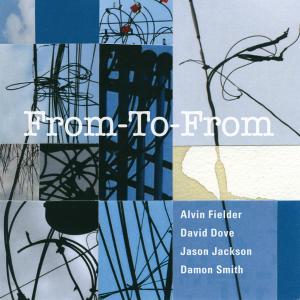
"Sextessense"
Musicians: Bennet / Bryerton / Butcher / De Gruttola/ Kaiser / Smith
Reviewed by Nic Jones, All About Jazz
|
|


"Sextessense" — Reviewed by Nic Jones, All About Jazz

Musicians: Bennet / Bryerton / Butcher / De Gruttola/ Kaiser / Smith
Reviewed by Nic Jones, All About Jazz
|
|


Trio Concert in Chicago" Players: — Reviewed by Bill Meyer, Chicago Reader
Musicians: Guillermo Gregorio/jerome Bryerton/Damon Smith
Reviewed by Bill Meyer, Chicago Reader
|
||
 |
"Cruxes" — Reviewed by Nic Jones, All About Jazz
Musicians: Josephson/Leandre/Smith/Blume
Reviewed by Nic Jones, All About Jazz
|
"Ausfegen" — Reviewed by Jon Dale, Signal to Noise

Musicians: Hartsaw/Aspelin/Smith/Bryerton
Reviewed by Jon Dale, Signal to Noise
|
|


"Jus" — Reviewed by Massimo Ricci, Bagatellen

Musicians: Jacob Lindsay / Ava Mendoza / Damon Smith / Weasel Walter
Reviewed by Massimo Ricci, Bagatellen
A rather uncomfortable, half-pungent-half-refined improvisational proposition from a quartet of receptive-minded musicians whose inclinations and - at least to some extent - reputations should supposedly encourage full use of runaway blasts, critically reprehensible user-unfriendliness and hectic free-for-all. Curiously enough, the music ends up in sounding pretty much controlled for the large part of the program instead, countless perturbations notwithstanding. Apropos of this, a loud volume playback is suggested; the perennially non-complying scrutinizer decreed that the six tracks work satisfactorily in the lower regions of auricular sufferance as well.
Lindsay performs on various kinds of clarinet (Ab, Bb, bass and contrabass), negotiating the possibilities of a fair trade between absent restrictions and unrehearsed discipline, which causes his instruments to go furtively unnoticed in certain sections, only to suddenly emerge as the lead voice of sorts in the involuntary architecture, gorgeously misshapen secretions and a brawny timbral individuality in constant evidence. Mendoza - not at all times at the forefront in the mix, which is a plus in comparison with the proverbial egotist attitude of many guitarists - represents a hardly definable, yet still attention-grabbing factor, her mistreatment of the instrument applied with a leg on each side of Frithian tampering (please don’t hit me, Weasel) and spectroscopic imagery of electric humming, string resonance made hostage by the tendency to quietness that the players remarkably exhibit, and regularly too.
Smith, featured on 7-string Ergo bass and Lloopp software, appears as a silent prime mover behind the whole concept, gritty physicality and probing studiousness underlying an ever-conscious approach to the art of stealthy rendezvous in the obscure quarters of instrumental interaction. If there’s some measure of regular bass somewhere in there, I struggled to notice; inflexible abrasiveness and obdurately anti-tonal jarring premeditation, yes - all the way through. From time to time Walter sounds unusually detached but - more frequently - his drumming is as effective as pure caffeine, alternating sharp fragmentations of the rhythmic flow and asymmetrical nervousness to abrupt impetuous enlargements of the dynamic organs (that’s right, this description is spam-influenced) while maintaining an inimitable escapologist personality as far as the exact collocation of a fashionable percussive method is concerned.
Replete with unspeakable shrewdness, this album necessitates of lots of conscientious tries before starting to commit to memory even a single joint of its complicated articulation.
~ Massimo Ricci
"Thoughtbeetle" — Reviewed by Bill Shoemaker, Point of Departure

Musicians: Bertram Turetzky/Damon Smith
Reviewed by Bill Shoemaker, Point of Departure
|
|


"Jus & Ausfegen" — Reviewed by Ken Waxman

Musicians: Hartsaw/Aspelin/Smith/Bryerton & Lindsay/Mendoza/Smith/Walter
Reviewed by Ken Waxman
Like most other generalities, the differences between so-called European and so-called American free music are more purported then real. Especially in the 21st Century when jet planes, the Internet and other advances have shrunk inter-continental chasms, the gulf between the two proposed by musicians like Derek Bailey – who often had an axe as well as his guitar to grind – seem fanciful. Take these two notable quartet sessions for instance, united by the presence of Bay area bassist Damon Smith. Although Chicago-based Paul Hartsaw, who often works with keyboardist Jim Baker in his home town, brings jazz’s most characteristic instruments – his tenor and soprano saxophones – to the date, his subtle reed bites and blows wouldn’t be confused with the style of Windy City heroes like Johnny Griffin. Chicago-based drummer, Jerome Bryerton says he’s equally influenced by American and European drummers and has played with stylists as difference as Berlin-based multi-reedist Wolfgang Fuchs and Chicago trombonist Jeb Bishop. Furthermore the subtitle of Ausfegen, Dedicated to Joseph Beuys, refers to the work of the late [1921-1986] German Conceptual artist; with one track in particular a direct musical homage. Conversely, while the instrumentation – clarinets, guitar, bass and lloopp and percussion – on Jus may appear more overtly European, the sonic results are as all-American as the microtonal electro-acoustic experiments that have taken place in Northern California since in the early 1960s. Not only that, but Smith, (with guitarist Henry Kaiser) guitarist Ava Mendoza, (with band leader Moe! Staiano) and hyperactive drummer Weasel Walter (with just about everyone) have also been known to play high-velocity rock music as well as more delicate sonic expressions. Additionally, the Ab, Bb, bass and contrabass clarinet improvisations of Lindsay – a long-time Smith-associate – are fully in the tradition of other West Coast reed polymaths such as John Carter, Jimmy Giuffre and Vinny Golia. More overtly, tapestries of microtonal and adumbrating silences are woven into many of the tracks on Jus. “Quadrophobia” for instance, which unrolls at a pace slower than largo, revels in atonal peeping and chromatic probes from the clarinetist, tick-tock drum pacing and shattering wood-block smacks and blurry electronic looped passages. Eventually as the rasgueado guitar work and intermittent string plucks subside, the tune’s ultimate variant contrasts pure air currents with strident clarinet pops and wind-tunnel puffs that could arise from Walter’s bagpipe-chanter or Smith’s col legno bass strokes. Overcoming a variety of unconnected timbral movements and reed tongue stops, “Winter Lights” is similarly sonically diffuse. As the growling undertow from the contrabass clarinet remains almost static, a sequence of pitch-sliding string movements takes centrestage. Adagio in tempo, Mendoza’s finger-styled picks and multi effects link up with Smith’s seminal string shaking and Walter’s rolls, pops and drags until the interface fades into intermittent silences. Almost as low-key, the defining track on the other CD would seem to be “Broom with Red Bristles”. Celebrating Beuys’ own ausfegen when used a broom to sweep Berlin’s Karl Marx Platz, Aspelin strokes his guitar strings with a shop broom and Smith slides two bows on top of prone prepared double basses. Some movements are barely audible, other seems to warble with chromatic string exposition; and all are contrasted with circular breathing from Hartsaw and pitter-patter snare work and reverberating cymbals from Bryerton. Earlier on, unattached cymbals seem to be vibrating by themselves as the strings scratch abrasively – from beneath their respective bridges – and the reedist outputs strained split tones Even more expansive is the last track, “Pamphlet Printed on Plastic Bag” – which may be another art reference. No echoes of paper or plastic are audible. Instead you hear metallic clatter and bell-ringing from the percussionist; hearty slaps and rustling string motions from the bassist; guitar filigree; plus multiphonic timbres from the saxophonist, that make it appear as if he’s playing both his horns at once. Following an antiphonal middle section – which redirects the tempo – the four mesh for a contrapuntal finale of slurred and chiming fingering from Aspelin; sul tasto bowing from Smith; bell-popping and kit quivering from Bryerton; and tongue slaps and spetrofluctuation from Hartsaw. Europeanized or North-Americanized free music, the breath of inspiration on these discs may confound identification. Perhaps both should just be labeled as good music and let go at that. --Ken Waxman Track Listing: Dedicated: 1. Vitrine 2. Sand 3. Copper 4. Garbage 5. Stone 6. Paper 7. Broom with Red Bristles 8. Pamphlet Printed on Plastic Bag Personnel: Dedicated: Paul Hartsaw (tenor and soprano saxophones); Kristian Aspelin (guitar and broom); Damon Smith (bass) and Jerome Bryerton (percussion) Track Listing: Jus: 1. American Current 2. Translucency 3. Quadrophobia 4. Blown Out 5. Discrete Flower Symmetry 6. Winter Light Personnel: Jus: Jacob Lindsay (Ab, Bb, bass and contrabass clarinets); Ava Mendoza (guitar); Damon Smith (7-string ergo-bass and lloopp) and Weasel Walter (drums, percussion and bagpipe chanter) July 19, 2009
"Yclept" — Reviewed by Reviewed by: Johan RedinOriginally in Swedish on soundofmusic.nu

Musicians: Ulher / Shibolet / Snir / Brenner / Meyer / Smith / Bymel Yclept
Reviewed by Reviewed by: Johan RedinOriginally in Swedish on soundofmusic.nu
|
||
 |
 |
"Ausfegen" — Reviewed by Peter Margasak

Musicians: Kristian Aspelin / Paul Hartsaw / Damon Smith / Jerome Bryerton
Reviewed by Peter Margasak
For the 2007 release Ausfegen (Balance Point Acoustics), this transcontinental quartet—bassist Damon Smith and guitarist Kristian Aspelin from the Bay Area and saxophonist Paul Hartsaw and drummer Jerome Bryerton from Chicago—set out to pay homage to German conceptual artist Joseph Beuys. But as Smith explains in the liner notes, they weren’t sure it was worthwhile to simply claim they were inspired by Beuys, so they decided to make the connection more explicit. For the art piece he called Ausfegen, Beuys swept Berlin’s Marx-Engels-Platz, then encased the broom and all the detritus he’d collected in a vitrine. On the album Ausfegen, the cuts have titles like “Garbage,” “Sand,” and “Paper,” and for one track Aspelin laid his guitar flat and played it with a broom. Of course that’s not to say the listener needs to know any of this to appreciate the group’s tensile and tactile free improvisation. The clanging and clattering commotion is daubed with terse, fluid phrases—a postbop gesture by Hartsaw, a rumbling arco flurry by Smith—and each player manipulates fast-flying extended technique in carefully calibrated communication. —Peter Margasak
"Yclept" — Reviewed by Clifford Allen - Paris Transatlantic

Musicians: Ulher / Shibolet / Snir / Brenner / Meyer / Smith / Bymel
Reviewed by Clifford Allen - Paris Transatlantic
|
|


"Ug 53 Sandy Ewen / Damon Smith / Weasel Walter" — Reviewed by MASSIMO RICCI. TOUCHING EXTREMES

Musicians: Sandy Ewen / Damon Smith / Weasel Walter
Reviewed by MASSIMO RICCI. TOUCHING EXTREMES
|
"Ug 53 Sandy Ewen / Damon Smith / Weasel Walter" — Reviewed by Bruce Lee Gallanter, Downtown Music Gallery
Musicians: Sandy Ewen / Damon Smith / Weasel Walter
Reviewed by Bruce Lee Gallanter, Downtown Music Gallery
|
"Ug 53 Sandy Ewen / Damon Smith / Weasel Walter" — Reviewed by Reviewed by: Clifford Allen, One Final Note

Musicians: Sandy Ewen / Damon Smith / Weasel Walter
Reviewed by Reviewed by: Clifford Allen, One Final Note
No matter what angle one is approaching creative music from – and I’ll include oddball rock music and modern composition as well – and no matter how deep one digs, there will always be an underground. This sense of obscuring refers not only to DIY labels and concerts, but also the mere fact that if an artist doesn’t move within certain circles, their work might not get recognized. Take this trio disc from Houston guitarist Sandy Ewen, Houston-via-Oakland bassist Damon Smith, and Brooklyn-via Oakland/Chicago percussionist Weasel Walter. To put it mildly, the eight improvisations here are overarchingly dense and incredibly abstract, often garish and resoundingly physical blasts of heat, noise, and vocabulary extensions. All three of the musicians on this disc (recorded at New York’s WKCR in one, uninterrupted swoop in November 2011) are – even with the visibility afforded by the internet and Walter’s sizable ugEXPLODE catalog of releases – rather far outside the free music mainline.
Though this recording is Ewen’s first to potentially catch the ear of free improvisation aficionados, she’s been quite visible in Texas music for the better part of a decade. Her guitar and voice comprise one fourth of The Weird Weeds, an open-ended and minimalist avant-rock quartet founded in 2004; she’s also worked in Spiderwebs with Texas/NYC psych guitarist Tom Carter and in a wide array of unrecorded and unclassifiable outfits. It’s interesting to think of her as a “fresh face” on the broader stage of improvised music, though I suppose her work just hasn’t had the chance to cross over until now. Walter and Smith were almost inseparable as a rhythm section during the former’s time in the Bay Area (2003-2009), and the drummer has – despite playing high-octane, energy-based free music both in the first half of the 1990s (with the Flying Luttenbachers) and extensively over the past decade – remained a “rock” musician in the eyes of the critical establishment.
This CD follows in the footsteps of Walter’s improvised collaborations with guitarists like Jim O’Rourke, Kevin Drumm, and Henry Kaiser, and while Ewen’s approach is very much her own (chalk slide, violin bow, cat brush, and pedals enter into her palette), the results are in keeping with a brutal hum of activity. Adding to the trio’s spidery wall is Smith’s curious setup, which includes laptop and field recordings in addition to a seven-string electric upright bass, played horizontally. Ewen doesn’t approach the level of phrasal logic that Kaiser or Mary Halvorson (another frequent Walter collaborator) put forth, which lends the music a somewhat more anarchic vibe. But that’s not to say that her strokes and wiry aggregates aren’t clear or that her actions don’t “flow,” because intent and listening are in the forefront of Ewen’s contributions to this recording. Walter has a way of playing “quietly” with terse acuity, so that passages of improvisation with a lower volume and instrumental sparseness retain momentum and palpable density. Were it not for the directness of attack that cuts through the trio’s playing, the eighty minutes of unruly electrified clatter on offer here might flag, but continually refined accents and concentrated unpredictability make the tooth and noise part of a spry and engaging set. One final note: though this is far from “free rock,” as with Masayuki Takayanagi’s “Mass Projections” and music of that ilk, this disc benefits from being played very loud. –Clifford Allen
"Ug 53 Sandy Ewen / Damon Smith / Weasel Walter" — Reviewed by EYAL HAREUVEN

Musicians: Sandy Ewen / Damon Smith / Weasel Walter
Reviewed by EYAL HAREUVEN
I
This uncompromising set of free improvisation challenges the very basic concepts of what music is. As seminal improvising guitarist Henry Kaiser writes in his illuminating liner notes: "forget about melody, harmony and rhythm for the moment and listen to everything else that you can hear going on." And there is much going on in terms of structural, timbral, spatial and conceptual complexity in these eight non-idiomatic, on-the-spot improvisations. Houston-based Sandy Ewen experiments with the electric guitar with various enhancements and preparations, as well as contributing art work to the booklet and cover; prolific improvisers, bassist Damon Smith and percussionist Weasel Walter, add their urgent, inventive ideas. All three have highly personal approaches and extended vocabularies on their instruments: Ewen uses amplification, feedback and distortion in an organic manner; Smith has mastered extended techniques on the bass and adds alien field recordings; and Walter's restless and anarchistic rhythmic sense defies all logic. All the improvisations disrupt any attempts at linear patterns or coherent structures. The sonic spectrum does not register as coming from regular instruments, especially Ewen's guitar and Smith's electric upright bass, and often produce sounds akin to noise. There is never obvious tension-building and tension-releasing in these improvisations; all of these hyperactive, wild abstractions assume that music asks questions, rather than providing answers. This kind of music cannot be notated in any Euro-Western musical system. Still, this trio creates arresting, otherworldly musical forms and sounds, honing its own immediate, extreme and unpredictable interplay as it expands methods of constructing and deconstructing musical ideas. Focused and uncompromising, weird and radical yet varied, often playful and always interesting. Track Listing: 1; 2; 3; 4; 5; 6; 7; 8. Personnel: Sandy Ewen: guitar; Damon Smith: 7-string electric upright bass, field recordings, laptop; Weasel Walter: percussion.
"Ug 53 Sandy Ewen / Damon Smith / Weasel Walter" — Reviewed by Ken Waxman, JazzWord

Musicians: Sandy Ewen / Damon Smith / Weasel Walter
Reviewed by Ken Waxman, JazzWord
Sandy Ewen/Damon Smith/Weasel Walter
UgEXPLODE ug53
Die Dicken Finger
Offroad Core
Gligg Records 012
With more-or-less the same instrumental line-up as a customary Rock power trio, these ensembles nonetheless stretch the expected timbral concord into experimental territory without sacrificing the speed and power associated with Hard Rock.
Cunning in its subtle distortion of electric guitar-electric-bass-drums motifs, the German trio Die Dicken Finger (DDF) or in English “The thickness of the fingers” could likely sneak onto a bill at a Heavy Metal festival until the realization dawned that the all-instrumental band was playing riffs just a little too sophisticated for the show. Committed to interjecting unexpected improvised asides into their music, the Americans on the other CD proclaim their individuality with the miscellaneous percussion brought to the gig by New York’s Weasel Walter plus the laptop and field recordings utilized alongside his 7-string upright bass by Houston’s Damon Smith. At the same time Sandy Ewen, another Houston resident, busies herself creating the expected electric guitar riffs and distortion. Berlin-based, the members of Die Dicken Finger also have impressive credentials working with more Jazz-oriented players. Guitarist Olaf Rupp for instance is in bands with the likes of trombonist Matthias Müller and drummer Tony Buck; bassist Jan Roder with bass clarinetist Rudi Mahall; and drummer Oli Steidle with pianist Aki Takase and Mahall. Those associations have to be set aside during the six tracks on DDF’s CD since this is Heavy Metal Jazz at its zenith – or most bombastic – if you prefer. Steidle’s pop, ruffs and forceful backbeat plus cymbal slaps are always audible; Roder’s sluicing bass rumbles plug any holes left in the performances; and Rupp’s guitar lines either twang like they’re trying to reach the top row in a sports arena or vibrate with reed-like sophistication. Throughout whether upfront are slurred fingering, crunching licks or press rolls, the focus is on kinetic coloration – damn the delicacy. At the same time, when the trio is fully immersed in its particular improv variant as on the more-than-10½- minute “Tilt Shift Capital”, a brutalist subtlety is present as well. Studding the dense sound mosaic is dramatic rasgueado from the guitarist that holds fast to the melody, as the bass and drum somersault through changes in tempo, rhythm and intensity. By the finale the staccato evolution seems as cleansing as it is unstoppable.
Similarly unstoppable, but much less wedded to expected Metal tropes are Ewen, Smith and Walter (ESW). Least known of the three is Ewen, a member of the rock band Weird Weeds, who has also played with improv trombonist David Dove. Initially from the Bay area, Smith has worked with many improvisers including pianist Scott Looney and saxophonist Wolfgang Fuchs; while Walter has gigged with just about everyone ranging from trumpeter Peter Evans to multi-reedist Vinny Golia.
Crackling and scrubbed guitar runs coupled with fuzzy electric bass shuffles or sul ponticello plucks plus unexplained rhythms on unnamed percussion constitute the trio’s game plan on the CD’s eight untitled selections. Nevertheless ESW traffics in less easily identifiable timbres than DDF. With the interface on tracks such as the fourth scurrying from Free Music-like dissonant rustles and rubs to Heavy Metal styled pressurized thumps, the beat is in contrast sometimes arrhythmic. Textures that could be old-time cash registers pinging, ancient doors creaking or signal-processed whistling leech into the improvisations. Here it’s Ewan’s slowed down claw-hammer licks and Smith’s hand pressured strokes that define the piece. Walter’s ratamacues as well as plinks and pops on vibes-like bars define the succeeding track, although it appears that Ewen and Smith are detuning and shaking different string combinations as they dart in and out of the narrative. Blurring the sound picture are static and pre-recorded voices slowed down, sped up and run backwards via Smith’s field recordings. Finally the percussionist’s bravado bounces and rolls knit the parts together. While aviary cries and metallic thumps appear elsewhere at odd intervals on the disc, ESW gets to expand its strategy to its threshold on the more-than-17½ minute sixth track. Used for idea expression not showy excess, both industrial sound reflections and experimental techniques are taken to logical conclusions. Consequently when a sudden burst of guitar fissure meets over-amplified spiccato plucks from the 7-string, it leads to descending twangs and frailing from Ewen, matched by Smith’s hand-heel hammering. Swelling to an ear-splitting screech that combines frenetic guitar strokes as buzzing bass pops, the narrative is further complicated as blurry laptop oscillations are laid on top of those timbres. Finally using bass drum smacks and hollow conga-like pats, Walter connects the others’ broken-chord improvising long enough to create an ending. Never to be confused with either a mainstream Jazz guitar-bass-drum trio or a Black Metal trio, each of these bands has created a CD which provides original variants on the sounds usually produced by this instrumental combination.
-- Ken Waxman
Track Listing: Sandy: 1. (9:48) 2. (11:37); 3. (9:25); 4. (11:08); 5. (7:51); 6. (17:31) 7. (4:09) 8. (7:19) Personnel: Sandy: Sandy Ewen (guitar); Damon Smith (7-String electric upright bass, laptop computer and field Recordings) and Weasel Walter (drums)
Track Listing: Offroad: 1. Optimus Prime 2. Carla Munksolm 3. Simsabaling 4. Tilt Shift Capital 5. Bumblebee 6. Gone Forever Personnel: Offroad: Olaf Rupp (guitar); Jan Roder (electric bass) and Oliver Steidle (drums)
February 17, 2013
"Not a recording , Damon talking about Cy Twombly" — Reviewed by Molly Glentzer
Musicians: Damon Smith
Reviewed by Molly Glentzer
|
|


"BPA -1 Background Information" — Reviewed by Steve Jansen

Musicians: Sandy Ewen / Damon Smith
Reviewed by Steve Jansen
This online release on Damon Smith’s label features the Houston-based double bass player and laptop sound adder/field recorder teaming up with Houston-based Sandy Ewen and her prepared guitar amblings. The four entirely improvised tracks were recorded in 2011 over three sessions and are "pure" -- meaning, there are no overdubs or effects, save for Ewen’s pan pedal.
The first track (each tune on the four-track album is named 1, 2, 3, and 4) begins with Ewen’s scratchy, jangling guitar that pans left and right. In the background, Smith’s laptop-scapes includes something that sounds like it’s coming from the inside of an auto mechanic’s shop. Later, a recording of a bleak factory or a droning industrial strength air conditioner. Overall, the tune, which goes nowhere fast (but not fast enough), is interesting for maybe five minutes, but not for the 21-minute-plus run time.
On the following number, Smith ditches the laptop and plays bass that coaxes a feeling of uneasiness. Ewen adds little paper crumpling sounds before taking a beautiful chalk-guitar solo, with Smith providing a rumbling bass footing. It's the album's best moment.
The third tune is a sonically fuller piece compared to the sparse/minimal directions of the previous tracks. There are equal parts of coming together on guitar, bass, and laptop, and periods of white space. The finale of the 2013 album listens like a sound study that one might come across at a conceptual art gallery or a college campus music building.
"BPA -1 Background Information" — Reviewed by Brian Olewnick , Just Outside

Musicians: Sandy Ewen / Damon Smith
Reviewed by Brian Olewnick , Just Outside
Sandy Ewen/Damon Smith - Background Information (Balance Point Acoustics)
This release is unusual, for me, for a couple of reasons. One, I'm writing about it based on downloaded sound files heard over my Macbook, something I prefer not to do for obvious sound quality reasons but, that's how it was presented so all caveats therein apply. Second, the duo, guitar and bass with objects, laptop and field recordings, at least abuts on an area that I'm less than comfortable with, the more fervently active area of free improv, that space where my subjective sense iis one of claustrophobia, where, despite the appellation 'free improv' there exist entire worlds of sound that simply won't be admitted. I don't know Ewen's work as near as I can recall, but I've heard an amount of Smith's over the years and have noted that he often straddles these fussy divides, working with Rowe here, Kaiser there, etc. So I was intrigued. As is usually the case, matters are more complicated than easy preconceptions.
The first of four tracks indeed begins in that scratchy realm, the pair sounding as though irritating their strings with combs or other thin, plastic objects. It's an active, prickly 'scape, the sort I often lose patience with. about midway through its 21 minutes, however, the pair ratchet things down just a tad and it's enough to veer the music (to my ears) into a much more enjoyable area, one adjacent to the quite/rough work Rowe has been doing in recent years (with Sachiko M on "contact", for example). Later, some plucks acquire a crystalline aspect that's quite appealing, though the agitative approach also regains sway; an interesting, expansive track though, even if it gave me some agita. The second track begins even more forthrightly in the scratchy zone before veering abruptly into some deliciously sour dronage; again, a half and half experience for this listener. Similarly, even more so, for the next piece, ranging from more extreme assertiveness to delicate plinking over distant, tolling tones; I want to hear more space--the guitar especially, in those otherwise very attractive latter moments, feels intrusive and inconsiderate though, again, the very last sounds, over Smith's rich arco, are delightful. The final cut doesn't stray far either, more brutally rubbed strings here--you can feel catgut straining.
There's a sameness of surface that nags at me here. Every time I pick up Smith's beautiful low playing, I want more and I want it surrounded by either simply the room or adjacent to a companion who's willing to lay out more than Ewen. That approach, though, is very much in keeping with a certain method of attack and it's done quite well; it's just not my particular cuppa. As is, there are nuggets to extract here and "Background Information" is worth hearing, even by those who share my inclinations, if only to shake it up a bit. I'm guessing Smith is quite aware of these issues, perhaps doesn't consider them issues at all. Listened to as a kind of counter-argument to my preconceived notions, it's good, wry fun.
Burns Longer — Reviewed by Brian Olewnick , Just Outside

Musicians: Fred Van Hove/Damon Smith/Peter Jacquemyn
Reviewed by Brian Olewnick , Just Outside
|
||
 |
"BPA 015 From-To-From" — Reviewed by Brian Olewnick , Just Outside

Musicians: Alvin Fielder/David Dove/Jason Jackson/Damon Smith
Reviewed by Brian Olewnick , Just Outside
Alvin Fielder/David Dove/Jason Jackson/Damon Smith - From to From (Balance Point Acoustics)
Readers know my problematic relationship with jazz post-1980 or so, especially that branch which styles itself as "free" but to my ears is often anything but, rarely recapturing the excitement, visceral and intellectual, of the AACM in its prime, Taylor, what-have-you. I understand exceptions will always exist and while I operate under the assumption that, all things considered, it's not worth wading through that particular morass on the off-chance of locating a jewel, things wend their way to me and I'm usually more than willing to give a fair listen. Sometimes you get lucky.
Though I've only encountered his post-60s work sporadically, I've always enjoyed Alvin Fielder. Fielder strikes me as the spine of this quartet (with David Dove on trombone, Jason Jackson on alto, tenor and baritone and Damon Smith on double bass). 77 years old at the time of the recoding, his work throughout is consistently alove and inventive,, "free" in non-obvious ways, nothing routine. His sensibility often recalls Blackwell, always a great thing for this listener. The music itself ahres much of this conception as well; themes arise, though they tend to do so subtly, but usually dissipate into group playing. There are solos, more or less, but you never get the sense of the kind of stagnant theme/solos/theme structure that I've heard all too often in much purportedly free music of the last couple of decades. Jackson will begin playing only to find, less than a minute later, that Dove enters in. As well, Fielder and Smith don't engage in "support"--that age old idea of Ornette's that rarely receives more than lip service, where the rhythm section is on equal footing with the horns, is always the case here. Again though, for me, it's Fielder who keeps things moving, who stirs the kettle so that nothing stick to the bottom. Jackson, apparently a fairly young player, wears his influences openly on the one hand (I hear Shepp and McPhee among others) but also has his own sound, a wide, roaring one, like a more soulful Gustafsson. I don't recall if I've ever heard Dove's trombone work before (I know of him more as a music organizer); Rudd is clearly in his sound but he also creates his own world and has a good knack for note distribution. This is busy music, no doubt, but manages to remain very fluid (Fielder again), never really treading water. There are moment, like midway through the title track, where I'm reminded of an old favorite band, the mid-70s Shepp group with Charles Majid Greenlee, Cameron Brown and Beaver Harris (where's Burrell?). I don't mean that as a backhanded compliment--I think generating that level of music in 2013 is no mean feat.
A solid, all around vigorous and enjoyable recording